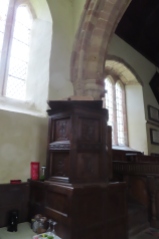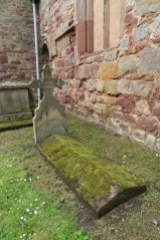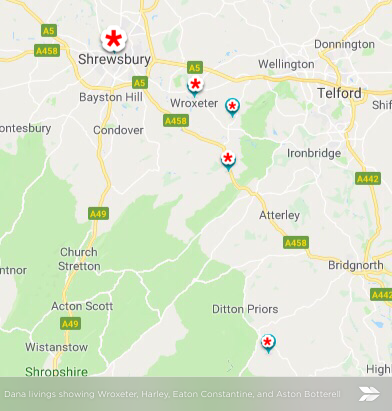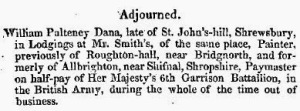My 4th great grandmother Elizabeth Hughes née Jones was born in 1798, the daughter of Edward Jones, a farmer, and Elizabeth Jones née Humphreys. In 1825 Elizabeth married Edward Hughes in Liverpool. She died in Melbourne in 1865. Her husband supplied the information on her death certificate, but although he gave the names of Elizabeth’s parents, for ‘place of birth’ only the county, Cardiganshire, was recorded. The 1851 census also recorded her place of birth as Cardiganshire with no further details.
In Cherry Stones, an account of our Hughes family history, my cousin Helen Hudson wrote:
Elizabeth Jones, Edward’s wife, was the youngest member of a large family. Her father, Evan Jones, known as Squire Jones, was a wealthy farmer in Cardiganshire. Elizabeth was described as a “clever, cultured lady, related in some way to Lord Westbury’s family." Maybe that was another legend, but like all these family stories there is always a grain of truth somewhere, even if distorted.
When in 1847 Elizabeth’s son, my 3rd great grand uncle Goodman Hughes, died in Marine Terrace, Shrewsbury, the death certificate informant was Annie Jones. Who was she? On the 1851 census Annie Wilton, née Jones, was living at Marine Terrace with her parents Evan and Mary Jones. Evan Jones was a sadler, born in Cardiganshire, aged 66 (so born about 1785). From this it seems likely that Evan Jones was a brother of my 4th great grandmother Elizabeth.

Evan Jones’s birthplace on the 1851 census is hard to read. Ancestry.com has transcribed it as ‘Caergonyall in Cardiganshire’. FindMyPast has ‘Caergonydd’. I agree that the name ends with “dd”, but I can find neither placename in Wikipedia’s list of Cardiganshire villages whose names begin with the letter C.
I decided to search for baptisms of ‘Evan’ around 1785 and ‘Elizabeth’ around 1798 in Cardiganshire with the father named Edward. I found only two.
There is an Evan Jones, father Edward Jones, gentleman, baptised 18 May 1784 at Llanfihangel Genau’r-glyn, Cardiganshire, Wales. And on 26 September 1798 there was a baptism at Llanfihangel Genau’r-glyn, Cardiganshire, Wales, of Elizabeth Jones daughter of Edward Jones, gentleman.
I next looked for a marriage of Edward Jones to Elizabeth Humphreys in the district. On 2 June 1778 an Edward Jones, gentleman, of Llanfihanel Gennery Glynn, Cardigan, married Elizabeth Humphreys at Tywyn, Merionethshire. She was of the parish. They married by licence. The witnesses were V??? Humphreys and John Jones.

Among the papers of a solicitor named John Thomas Herbert Parry, of Glan-paith, Llanbadarn Fawr, Cardiganshire, that were deposited with the National Library of Wales in the 1930s, is the following document:
Title Glan Paith Papers reference 212: Release (in consideration of the intended marriage of the said Edward Jones and the said Elizabeth Humphreys), to make a …, Creation Date 1778, May 30.
Description 1. Edward Jones. 2. Humphrey Jones. 3. Evan Watkin of Moelyherney, p. Llanfyhangelgenerglyn, co. Card., gent. 4. Evan Evans of Knwcybarkit, p. Llanygrowthen, co. Card., and Thomas Pugh of Glanyrafon, p. Llanfyhangelgenerglyn aforesaid, gent's. 5. Mary Humphreys, widow, and Elizabeth Humphreys, spinster, her eldest daughter, both of Towyn, co. Mer. Release (in consideration of the intended marriage of the said Edward Jones and the said Elizabeth Humphreys), to make a tenant to the praecipe for the suffering of a recovery, of Tythin Carreg Cadwgan, Tythyn panty Carrw, Tythin y nantgarrw, Tythin Coed-y-Bongam, Llertai Gleission, Tythin-y-Tymawr, Llyesty Pant Gwynne, and Rhydyrhenedd in the t. of Caylan and Maesmore, p. Llanfihangel generglyn.
The paper immediately preceding 211 is dated 29 May 1778 and concerns the Lease for one year of Tythin Carreg Cadwgan, Tythyn panty Carrw, Tythin y nantgarrw, Tythin Coed-y-Bongam, Llertai Gleission, Tythin-y-Tymawr, Llyesty …,
1. Edward Jones of Carregcadwgan, p. Llanfihangelgenerglyn, co. Card., gent. 2. Humphrey Jones of the town of Machynlleth, co. Mont., gent. Lease for one year of Tythin Carreg Cadwgan, Tythyn panty Carrw, Tythin y nantgarrw, Tythin Coed-y-Bongam, Llertai Gleission, Tythin-y-Tymawr, Llyesty Pant Gwynne, and Rhydyrhenedd in the t. of Caylan and Maesmore, p. Llanfihangel generglyn aforesaid.
Paper 214 dated 1 March 1803 concerns the Lease for one year of Tythin Carreg Cadwgan, Tythin panty Carrw, Tythin y nant garrw, Tythin coed y Bongam, Llertaigleission …,
1. Edward Jones, gent., and Elizabeth, his wife, and John Jones, gent., their son and heir apparent, all of Carreg Cadwgan, p. Llanfihangelgenerglyn, co. Card. 2. John Beynon of Newcastle Emlyn, co. Carm., gent. Lease for one year of Tythin Carreg Cadwgan, Tythin panty Carrw, Tythin y nant garrw, Tythin coed y Bongam, Llertaigleission, Tythin y Ty mawr, and Rhydyrhenedd, with a cottage called Llyesty Pantygwynne, in the t. of Caylan and Maesmore, p. Llanfihangelgenerglyn aforesaid.
Paper 215 is dated 2 March 1803 and concerns Release, to make a tenant to the praecipe for the suffering of a recovery, of Tythin Carreg Cadwgan, Tythin panty …,
1. Edward Jones and Elizabeth, his wife, and John Jones. 2. John Beynon. 3. Humphrey Jones of the town of Machynlleth, co. Mont., esq. Release, to make a tenant to the praecipe for the suffering of a recovery, of Tythin Carreg Cadwgan, Tythin panty Carrw, Tythin y nant garrw, Tythin coed y Bongam, Llertaigleission, Tythin y Ty mawr, and Rhydyrhenedd, with a cottage called Llyesty Pantygwynne, in the t. of Caylan and Maesmore, p. Llanfihangelgenerglyn aforesaid.
I looked for the baptism of John Jones and found John, son of Edward Jones by his wife, baptised 15 January 1782 at Llanfihangel Genau’r-glyn, Cardiganshire.
I think this is the Edward Jones and Elizabeth Jones née Humphreys I have been looking for, but I have not yet found a will or any other document that would make me completely confident of the connection.
It appears from the document of 30 May 1778 that Elizabeth Humphreys and her widowed mother Mary came from Towyn, co. Mer. Today this town is spelt as Tywyn. I have found a will dated 1772 by Griffith Humphreys, a yeoman of Tywyn, Merioneth, which mentions his wife Mary and his daughter Elizabeth.
The village of Llanfihangel Genau’r Glyn, is now known as LLandre. The older name means St Michaels at the Mouth of the Valley. Llanfihangel is a very common placename in Wales and the name LLandre was changed to avoid confusion. Llandre means ‘Churchtown’.
As the crow flies Llandre is ten miles from Tywyn, but by road via the nearest bridge across the Dyfi river the distance is more than double this. Perhaps they crossed by boat at Aberdyfi.
The geography images site geograph.org has photograph of a farm called Carregcadwgan. I wonder if this is the farm associated with Edward Jones and mentioned in the lease document of 29 May 1778 and again in the lease document of 1 March 1803. Carregcadwgan farm is 5 miles east of Llandre. The community location, a settlement which could not even be described as a hamlet, is called Ceulanamaesmawr.
All this is progress, I suppose, but I am still trying to discover more about the Jones and Humphreys families. I wonder why Elizabeth moved more than a hundred miles north from Cardiganshire to Liverpool to marry Edward Hughes and why her brother Evan moved seventy-five miles east to settle in Shrewsbury.
Related posts
Wikitree:

































































